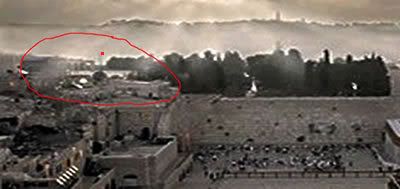|
Symbolic Terrorism Revisited: Hagee's CUFI 'Wipes' Islam's 3rd Holiest Site From Logo
One of the key events necessary to trigger the end-of-days scenario expected in the Christian end-time theology, known as apocalyptic premillennial dispensationalism, that is held by Pastor John Hagee, much of his CUFI membership and tens of millions of Americans, is the rebuilding of a third Jewish temple on Jerusalem's Temple Mount, a spot considered one of the most highly charged possible flash points of conflict on Earth. Thus, one of the central organizational responsibilities of Israel's domestic security force, Shin Bet, is to prevent possible attacks, on the Islamic structures on and around Jerusalem's Temple Mount, by Jewish or Christian, or even Islamic, terrorist groups. In his 2002 book The End of Days: Fundamentalism and the Struggle for the Temple Mount Israeli Journalist Gershom Gorenberg analyzes the volatile religious significance of the Temple Mount. As the Oxford University Press summarizes, "Members of the world's three major monotheistic faiths--Judaism, Christianity, and Islam--hold this spot to be the key to salvation as they await the end of the world", and as a Publisher's Weekly review describes Gorenberg's work, "Jewish messianists and Christian millennialists insist that building the Third Temple on the site where both Solomon's and Herod's temples stood is essential for the advent of the Messiah, while Muslim apocalyptic believers fear that efforts to destroy Al-Aqsa mosque to make way for the Third Temple will prevent fulfillment of the prophecy about Islam's Meccan shrine migrating to Jerusalem at the end of time... Gorenberg's prescience is manifest by his calling Temple Mount "a sacred blasting cap" and by stating that "any incident at the site can spin out of control." But maintaining the peace in the volatile Mideast region does not appear to be high on the agenda of pastor John Hagee and other evangelical leaders now under CUFI's aegis.
CUFI's first response, to the charge that the Dome of The Rock had been airbrushed from the image used in its logo was to deny it and claim the Dome was missing simply because of a question of perspective. In my April 14 piece though, I provided a number of pictures, of the same site- the Wailing Wall and the Temple Mt., which showed that claim was highly unlikely and even impossible. In a followup story, CUFI's Odd Case Of the Dome That Vanished In The Night, I discussed the outcome, as a New York Jewish Telegraph Agency news story stated, unequivocally, that the image had indeed been wiped. CUFI then changed its story and stated that the image had indeed been altered but not under CUFI's direction - the image, the group said, had been airbrushed by the artist who took the photograph from which the image was derived. The suggestion was that CUFI's use of the w | |||||||||||




 print page
print page
 Since the founding of John Hagee's Christians United For Israel, Hagee has built up a major national profile and, at the AIPAC 2007 annual conference, addressed a significant fraction of both houses of the US Congress. Few observers paid attention to the political extremity of Hagee's new group but CUFI's original logo, featured at its events, on its printed material and on CUFI's website broadcast CUFI's apocalyptic aspirations with unmistakable symbolic force. The logo featured a picture from which the Dome of The Rock, considered the 3rd holiest site to Islam, had been airbrushed out. In symbolic terms, CUFI's logo depicted what Israel's internal security force Shin Bet views as a potentially catastrophic act of religious terrorism. [image, upper right: old "wiped" and new "unwiped" CUFI logo images]
Since the founding of John Hagee's Christians United For Israel, Hagee has built up a major national profile and, at the AIPAC 2007 annual conference, addressed a significant fraction of both houses of the US Congress. Few observers paid attention to the political extremity of Hagee's new group but CUFI's original logo, featured at its events, on its printed material and on CUFI's website broadcast CUFI's apocalyptic aspirations with unmistakable symbolic force. The logo featured a picture from which the Dome of The Rock, considered the 3rd holiest site to Islam, had been airbrushed out. In symbolic terms, CUFI's logo depicted what Israel's internal security force Shin Bet views as a potentially catastrophic act of religious terrorism. [image, upper right: old "wiped" and new "unwiped" CUFI logo images]
 As the JTA news service
As the JTA news service